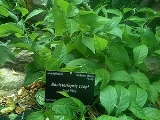
Banisteriopsis caapi
Encyclopedia
Banisteriopsis caapi, also known as Ayahuasca, Caapi or Yage, is a South America
n jungle vine of the family Malpighiaceae. It is used to prepare Ayahuasca
, a decoction
that has a long history of entheogen
ic uses as a medicine and "plant teacher" among the indigenous peoples
of the Amazon Rainforest
. It contains harmine, harmaline, and tetrahydroharmine, all of which are both beta-carboline
harmala alkaloid
s and MAOIs. The MAOIs in B. caapi allow the primary psychoactive compound, DMT (which is introduced from the other primary ingredient in Ayahausca, the Psychotria viridis
plant), to be orally active. The stems contain 0.11-0.83% beta-carboline
s, with harmine
and tetrahydroharmine as the major components.
According to The CRC World Dictionary of Plant Names by Umberto Quattrocchi, the naming of B. caapi was actually dedicated to John Banister, a seventeenth-century English clergyman and naturalist. An earlier name for the genus
Banisteriopsis was Banisteria, and the plant is sometimes referred to as Banisteria caapi in everyday usage.
The name Ayahuasca means "vine of the soul" in Quechuan, and the shamans of the indigenous Western Amazonian tribes use the plant in religious and healing ceremonies. In addition to its hallucinogenic properties, caapi is used for its healing properties as a purgative, effectively cleansing the body of parasites and helping the digestive tract.
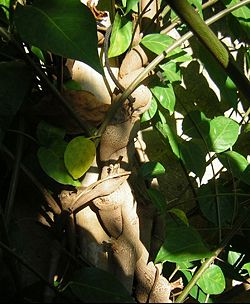
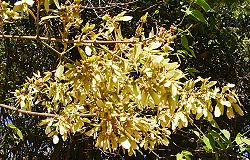
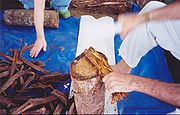
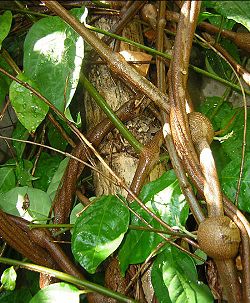
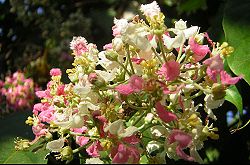 In the United States
In the United States
, caapi is not specifically regulated. A recent court case involving caapi-containing Ayahuasca (which also contains other plants containing the controlled substance DMT, introduced from the Psychotria viridis
plant), Gonzales v. O Centro Espirita Beneficente Uniao do Vegetal
, was found in favor of the União do Vegetal
, a Brazilian religious sect using the tea in their ceremonies and having around 130 members in the United States.
In Australia
, the harmala alkaloids are scheduled substances, including Harmine and harmaline, but the living vine, or other source plants are not in most states. On the State of Queensland as of March 2008 this distinction is now uncertain.
In all states the dried herb may or may not be considered a scheduled susbtance, dependent on court rulings.
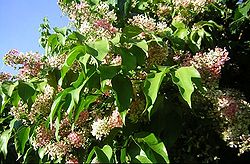 In Canada
In Canada
, harmala listed under the Controlled Drugs and Substances Act
as a schedule III substance, but the vine is not. (Note that Canadian scheduling laws are very different from their United States counterparts).
Caapi, as well as a range of harmala alkaloids, were recently scheduled in France
, following a court victory by the Santo Daime
religious sect allowing use of the tea due to it not being a chemical extraction and the fact that the plants used were not scheduled. Religious exceptions to narcotics laws are not allowed under French law, effectively making any use or possession of the tea illegal.
For more legal information, see Ayahuasca
.
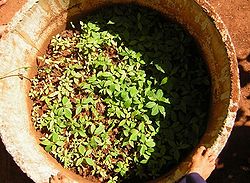 The caapi vine itself has been the subject of a dispute between U.S. entrepreneur Loren Miller and the Coordinating Body of Indigenous Organizations of the Amazon Basin (COICA). In 1986 Miller obtained a US patent
The caapi vine itself has been the subject of a dispute between U.S. entrepreneur Loren Miller and the Coordinating Body of Indigenous Organizations of the Amazon Basin (COICA). In 1986 Miller obtained a US patent
on a variety of B. caapi. COICA argued that the patent was invalid because Miller's variety had been previously described in the Herbarium of the University of Michigan, and was therefore neither new nor distinct. The patent was overturned in 1999; however, in 2001 the US Patent Office reinstated the patent because the law at the time the patent was granted did not allow a third party such as COICA standing to object. The Miller patent expired in 2003. B. caapi is now being cultivated commercially in Hawaii
.
South America
South America is a continent situated in the Western Hemisphere, mostly in the Southern Hemisphere, with a relatively small portion in the Northern Hemisphere. The continent is also considered a subcontinent of the Americas. It is bordered on the west by the Pacific Ocean and on the north and east...
n jungle vine of the family Malpighiaceae. It is used to prepare Ayahuasca
Ayahuasca
Ayahuasca is any of various psychoactive infusions or decoctions prepared from the Banisteriopsis spp. vine, usually mixed with the leaves of dimethyltryptamine-containing species of shrubs from the Psychotria genus...
, a decoction
Decoction
Decoction is a method of extraction, by boiling, of dissolved chemicals, or herbal or plant material, which may include stems, roots, bark and rhizomes. Decoction involves first mashing, and then boiling in water to extract oils, volatile organic compounds, and other chemical substances...
that has a long history of entheogen
Entheogen
An entheogen , in the strict sense, is a psychoactive substance used in a religious, shamanic, or spiritual context. Historically, entheogens were mostly derived from plant sources and have been used in a variety of traditional religious contexts...
ic uses as a medicine and "plant teacher" among the indigenous peoples
Indigenous peoples
Indigenous peoples are ethnic groups that are defined as indigenous according to one of the various definitions of the term, there is no universally accepted definition but most of which carry connotations of being the "original inhabitants" of a territory....
of the Amazon Rainforest
Amazon Rainforest
The Amazon Rainforest , also known in English as Amazonia or the Amazon Jungle, is a moist broadleaf forest that covers most of the Amazon Basin of South America...
. It contains harmine, harmaline, and tetrahydroharmine, all of which are both beta-carboline
Beta-carboline
β-Carboline is an organic amine that is the prototype of a class of compounds known as β-carbolines.-Pharmacology:...
harmala alkaloid
Harmala alkaloid
Several alkaloids that function as monoamine oxidase inhibitors are found in the seeds of Peganum harmala , including harmine, harmaline, and harmalol, which are members of a group of substances with a similar chemical structure collectively known as harmala alkaloids...
s and MAOIs. The MAOIs in B. caapi allow the primary psychoactive compound, DMT (which is introduced from the other primary ingredient in Ayahausca, the Psychotria viridis
Psychotria viridis
Psychotria viridis is a shrub from the coffee family, Rubiaceae. It has many local names, including Chacruna and Chacrona ....
plant), to be orally active. The stems contain 0.11-0.83% beta-carboline
Beta-carboline
β-Carboline is an organic amine that is the prototype of a class of compounds known as β-carbolines.-Pharmacology:...
s, with harmine
Harmine
Harmine is a fluorescent harmala alkaloid belonging to the beta-carboline family of compounds. It occurs in a number of different plants, most notably the Middle Eastern plant harmal or Syrian rue and the South American vine Banisteriopsis caapi...
and tetrahydroharmine as the major components.
According to The CRC World Dictionary of Plant Names by Umberto Quattrocchi, the naming of B. caapi was actually dedicated to John Banister, a seventeenth-century English clergyman and naturalist. An earlier name for the genus
Genus
In biology, a genus is a low-level taxonomic rank used in the biological classification of living and fossil organisms, which is an example of definition by genus and differentia...
Banisteriopsis was Banisteria, and the plant is sometimes referred to as Banisteria caapi in everyday usage.
The name Ayahuasca means "vine of the soul" in Quechuan, and the shamans of the indigenous Western Amazonian tribes use the plant in religious and healing ceremonies. In addition to its hallucinogenic properties, caapi is used for its healing properties as a purgative, effectively cleansing the body of parasites and helping the digestive tract.

Types of vine
There are two scientifically accepted varieties:- Banisteriopsis caapi var. caupuri with knotty stems
- Banisteriopsis caapi var. tukunaka with smooth stems



Legality

United States
The United States of America is a federal constitutional republic comprising fifty states and a federal district...
, caapi is not specifically regulated. A recent court case involving caapi-containing Ayahuasca (which also contains other plants containing the controlled substance DMT, introduced from the Psychotria viridis
Psychotria viridis
Psychotria viridis is a shrub from the coffee family, Rubiaceae. It has many local names, including Chacruna and Chacrona ....
plant), Gonzales v. O Centro Espirita Beneficente Uniao do Vegetal
Gonzales v. O Centro Espírita Beneficente União do Vegetal
Gonzales v. O Centro Espirita Beneficente Uniao do Vegetal, 546 U.S. 418 , is a case decided by the United States Supreme Court involving the Federal Government's seizure of a sacramental tea, containing a Schedule I substance, from a New Mexican branch of the Brazilian church União do Vegetal...
, was found in favor of the União do Vegetal
União do Vegetal
União do Vegetal is a Christian religion based on the use of Hoasca in a program of spiritual evolution based on mental concentration and the search for self-knowledge...
, a Brazilian religious sect using the tea in their ceremonies and having around 130 members in the United States.
In Australia
Australia
Australia , officially the Commonwealth of Australia, is a country in the Southern Hemisphere comprising the mainland of the Australian continent, the island of Tasmania, and numerous smaller islands in the Indian and Pacific Oceans. It is the world's sixth-largest country by total area...
, the harmala alkaloids are scheduled substances, including Harmine and harmaline, but the living vine, or other source plants are not in most states. On the State of Queensland as of March 2008 this distinction is now uncertain.
In all states the dried herb may or may not be considered a scheduled susbtance, dependent on court rulings.

Canada
Canada is a North American country consisting of ten provinces and three territories. Located in the northern part of the continent, it extends from the Atlantic Ocean in the east to the Pacific Ocean in the west, and northward into the Arctic Ocean...
, harmala listed under the Controlled Drugs and Substances Act
Controlled Drugs and Substances Act
The Controlled Drugs and Substances Act is Canada's federal drug control statute. Passed in 1996 by the Chrétien government, it repeals the Narcotic Control Act and Parts III and IV of the Food and Drug Act and establishes eight Schedules of controlled substances and two Classes of precursors...
as a schedule III substance, but the vine is not. (Note that Canadian scheduling laws are very different from their United States counterparts).
Caapi, as well as a range of harmala alkaloids, were recently scheduled in France
France
The French Republic , The French Republic , The French Republic , (commonly known as France , is a unitary semi-presidential republic in Western Europe with several overseas territories and islands located on other continents and in the Indian, Pacific, and Atlantic oceans. Metropolitan France...
, following a court victory by the Santo Daime
Santo Daime
Santo Daime is a syncretic spiritual practice founded in the 1930s in the Brazilian Amazonian state of Acre by Raimundo Irineu Serra, known as Mestre Irineu...
religious sect allowing use of the tea due to it not being a chemical extraction and the fact that the plants used were not scheduled. Religious exceptions to narcotics laws are not allowed under French law, effectively making any use or possession of the tea illegal.
For more legal information, see Ayahuasca
Ayahuasca
Ayahuasca is any of various psychoactive infusions or decoctions prepared from the Banisteriopsis spp. vine, usually mixed with the leaves of dimethyltryptamine-containing species of shrubs from the Psychotria genus...
.
Patent issues

Patent
A patent is a form of intellectual property. It consists of a set of exclusive rights granted by a sovereign state to an inventor or their assignee for a limited period of time in exchange for the public disclosure of an invention....
on a variety of B. caapi. COICA argued that the patent was invalid because Miller's variety had been previously described in the Herbarium of the University of Michigan, and was therefore neither new nor distinct. The patent was overturned in 1999; however, in 2001 the US Patent Office reinstated the patent because the law at the time the patent was granted did not allow a third party such as COICA standing to object. The Miller patent expired in 2003. B. caapi is now being cultivated commercially in Hawaii
Hawaii
Hawaii is the newest of the 50 U.S. states , and is the only U.S. state made up entirely of islands. It is the northernmost island group in Polynesia, occupying most of an archipelago in the central Pacific Ocean, southwest of the continental United States, southeast of Japan, and northeast of...
.
Alkaloids
- HarmineHarmineHarmine is a fluorescent harmala alkaloid belonging to the beta-carboline family of compounds. It occurs in a number of different plants, most notably the Middle Eastern plant harmal or Syrian rue and the South American vine Banisteriopsis caapi...
, 0.31-8.43%
- HarmalineHarmalineHarmaline is a fluorescent psychoactive indole alkaloid from the group of harmala alkaloids and beta-carbolines. It is the reduced hydrogenated form of harmine.-Occurrence in nature:...
, 0.03-0.83%
- Tetrahydroharmine, 0.05-2.94%
External links
- Banisteriopsis caapi List of Chemicals (Dr. Duke's Databases)
- Report on indigenous use of the plant, and the patent dispute
- Report on Beta-Carboline Containing Plants
- United States Patent # PP5,751, Miller, June 17, 1986, Banisteriopsis caapi (cv) `Da Vine`
- Erowid's Vault article on the plant
- A General Introduction to Ayahuasca
- Alkaloid Content of Banisteriopsis caapi

